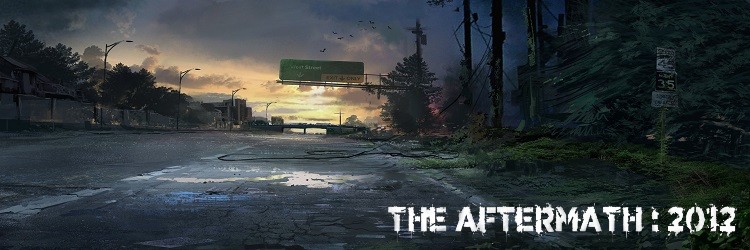
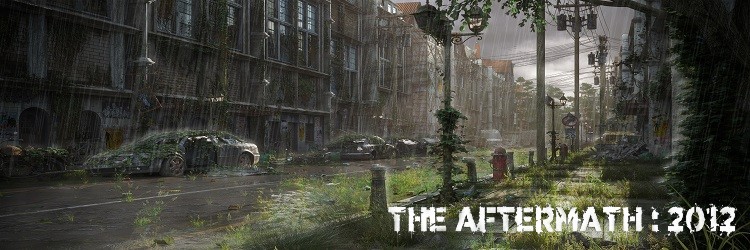
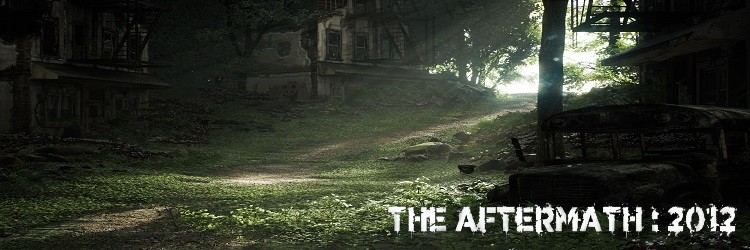
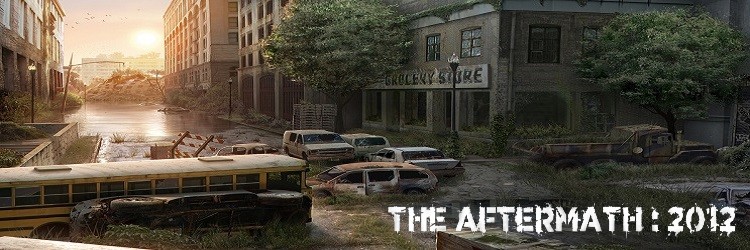
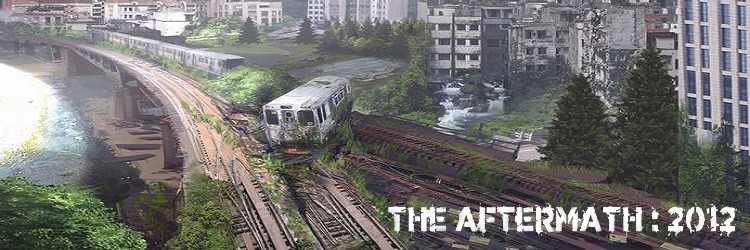
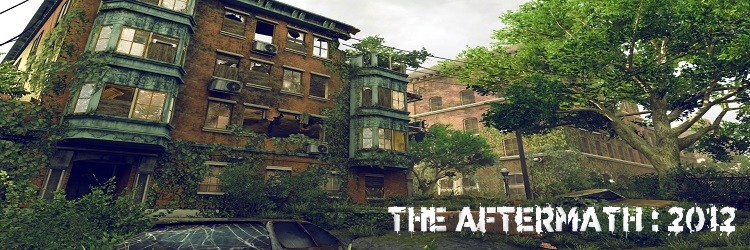
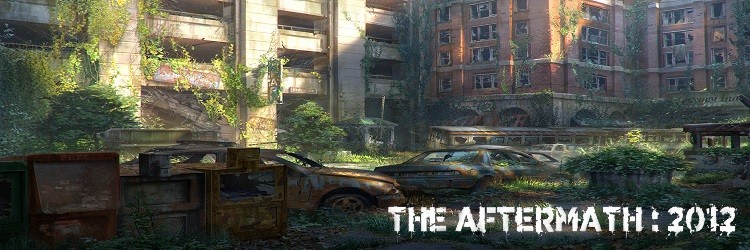

The Aftermath is a Role Playing Game (RPG) platform. All the "Rules" listed here are simply GUIDELINES as to how to make the most of this framework, they are NOT designed to be "Carved in Stone" and therefore constantly referenced during play! It is a reasonably complex system, built that way to address all aspects of life and death in the post-apocalypse. In spite of this it is intended to be "Loosely Guided" by whoever plays the role of the STORYTELLER. Games should IDEALLY never devolve into arguments on interpreting "Rule Legalese" !!!
The Aftermath is a Role Playing Game (RPG) platform. Nearly every RPG ever created functions similarly with its reliance upon a few core concepts. The games themselves require verbal exchange between the Players themselves, the Storyteller (DM for Dungeons & Dragons, GM for many others) and the Play System itself. Every participant has their own role to play in the narrative the Storyteller provides, which uses the System to represent any and every interaction between the Players and their environments. The quick and dirty version is as follows and reflect the key sections of this page:
One of the primary concepts regarding RPG's is the idea of Passive and Active Play. Passive play is where “immersion” factors into the account of any game. This is where the players gain insight, equipment, or otherwise become savvy to opportunities by playing their characters role in the storyteller's script. Any dice rolls or checks to determine the characters results and effects during passive play are demonstrated through the ability to dedicate extensive time and energy to achieve the results they are pursuing. In essence, passive play occurs gradually and the attention to detail focuses on the story itself, the characters in it, and the players dedication to plot development instead of the system itself. All of the time spent in games where the characters are in between adventures and developing the plot, shopping for equipment, and talking to other people is the prime example of passive play.
Active play, on the other hand is where the characters put their money where their mouth is. This would be any time a player fights, flees, sneaks around, climbs a mountain, or engages in any activity where every second and every move counts. These are the moments where the characters are really put to the test, the blood pumps and the adrenaline flows, where things get really exciting because the consequences are real but amazing things can occur. Active play happens any time the character finds themselves in danger, at which point the rule system becomes significantly more involved and complicated. What it really boils down to is the passing of time. During active play the time-frame slows down and the rules revolve around the concept of the ROUND. A round is a 3 second period where the characters and the storyteller's NON-PLAYER CHARACTERS (NPC's) maneuver with both haste and purpose, and in The Aftermath timing is everything.
The first thing that both the Players and Storytellers need to understand is about characters is their ATTRIBUTES. Attributes represent a characters natural developed physical and mental capacity to manipulate the world and are directly related to a new character's initial Skill Ratings. Skills represent a characters inherent knowledge, experience, and subject familiarity when performing complex tasks, whereas attributes embody a characters physical and mental prowess and potential for more generalized interactions
| RATING | RESULT | DESCRIPTION |
|---|---|---|
| 2 to 5 | INEPT | Any attribute at 5 or less indicates a severe deficiency, and the character should probably consider talking to a doctor. An attribute rating of 2 means that the character can barely function in this capacity, likely due to an injury, a mental health condition, or severe malnutrition or a combination of the three. |
| 6 to 10 | BELOW AVERAGE | Attributes between 6 and 10 indicate a weakness. The Apocalypse was hard, and the character is definitely carrying some burdens of one form or another |
| 11 to 15 | ABOVE AVERAGE | Attributes that fall between 11 and 15 are above average, meaning that the character is fully capable for feats of this particular nature |
| 16 to 20 | IMPRESSIVE | Any attribute that is 16 or better means that the character is particularly impressive in this dynamic. It should be noted that an attribute rating of 20 does not necessarily mean that the character belongs in the Olympic Games or the Guinness Book of World Records. It simply indicates that the character is operating at peak efficiency in this particular regard and that no further improvement can be made in a “general” sense |
| ATTRIBUTE | DEFINITION | EXAMPLE | COMMON USE |
|---|---|---|---|
| MEMORY | The faculty by which the mind stores and recalls information | Do you need to remember someones name? Something they said? The formula for calculating the circumference of a sphere? |
|
| LOGIC | Reasoning conducted according to strict principles of validity | Playing chess in the park? Trying to determine someone's motives? Figuring out what went or could go wrong based on certain evidence? |
|
| PERCEPTION | The ability to see, hear, or become aware of something through one of the five the senses | Do you need to know how many people are on the other side of a doorway while you listen in? Maybe you are trying to make sense of what your friend is screaming at you after the gunfire erupts? Need to assess the situation quickly? |
|
| WILLPOWER | Control or mental fortitude exerted in order to do something difficult or restrain impulses | You know those days when you just dont want to get out of bed? Got hurt yesterday so now you get to work with a broken thumb? Trying to quit smoking or workout every morning? Fighting pain, emotions, and rash decisions? |
|
| CHARISMA | Compelling social ability or charm that can inspire devotion in others | See, charisma is tricky. My personal interpretation is “the ability to persuade others to both see and agree with your line of thinking”. That is basically the entire goal of communication |
|
| ATTRIBUTE | DEFINITION | EXAMPLE | COMMON USE |
|---|---|---|---|
| STRENGTH | The quality or state of being strong; bodily or muscular power; vigor | Lifting, pushing, pulling, carrying, or otherwise affecting the physical world with ones own body. That is strength. |
|
| ENDURANCE | The ability to withstand hardship or adversity and / or sustain a prolonged stressful effort or activity | Keeping pace while running? Trying to fight off illness or infection? Maintain functionality after considerable blood loss? Carry a heavy pack long distances? Continue doing almost anything once it becomes difficult? |
|
| AGILITY | The ability to move, change direction or body position both quickly and easily. Body awareness, flexibility, and balance in a nutshell | Need to jump over an obstacle? How about scramble up a retaining wall or fence? Catch something thrown at you? Keep your balance? Jump out of a second story window without hurting yourself? |
|
| SPEED | The rate at which someone or something is able to move or operate | Need to haul ass towards or away from danger? Working on something that needed to be finished yesterday? In a standoff and want to be the first to make a move? |
|
| BEAUTY | A combination of qualities, such as shape, color or form that pleases the aesthetic senses of the beholder | This is your base aesthetic and physical attractiveness, plain and simple. Beauty as a attribute cannot be improved, only masked or modified |
|
People have their vices, sometimes it makes sense to strike when you know your target(s) will be inebriated. Sometimes it makes sense to be under the influence yourself, and sometimes the characters are just likely to need to find a way to cope or celebrate a victory. The truth is that partaking in mind altering substances is usually a social endeavor, and after so much loss and pain its likely that the characters in the Aftermath may pick up some bad habits. These things tend to affect the body in multiple ways:
There are two main types of SKILL CHECKS. These checks are handled by rolling D100. Again you roll 2D10 but one dice serves as the 10's digit, and one dice serves as the 1's digit. SKILL MODIFIERS work exactly like they do above in the Attributes Section but instead of changing Attribute Rating, they alter Skill Rating. The main types of Skill Checks consist of GENERAL SKILL CHECKS and RISKY SKILL CHECKS. There is also Critical Skill Rolls which are a sub sect of these two.
| COMPLEXITY | SKILL MODIFIER | ATTRIBUTE MODIFIER |
|---|---|---|
| SIMPLE | + 75 | + 6 |
| EASY | + 50 | + 4 |
| LIKELY | + 25 | + 2 |
| PROBABLE | + 10 | + 1 |
| STANDARD | 0 | 0 |
| IMPROBABLE | - 10 | - 1 |
| UNLIKELY | - 25 | - 2 |
| DIFFICULT | - 50 | - 4 |
| COMPLEX | - 75 | - 6 |
| INCREDIBLE | - 100 | - 8 |
| IMPOSSIBLE | - 125 | - 10 |
Now we are in to the thick of it, the “Do or Die”. Every interaction in combat is a Risky Skill / Attribute Check. Now or never. Remember that each ROUND of active play is approximately three seconds. For those of you reading this with no real life experience, violence is crazy and quick, period. Every move matters and this is what they mean when they talk about “The Quick and the Dead”. Everything changes right here, right now. The first thing players and storytellers need to understand is everyone gets ONE TURN PER ROUND (but characters can SAVE ACTIONS to interrupt someone else's turn later in the SEQUENCE!)
There are generally only two combat scenarios for determining character turn order. The AMBUSH SCENARIO (Surprise Attack) and the READY SCENARIO
When each round of combat is only three seconds you begin to understand the value of the Speed Attribute. Your Speed divided by two (rounded down) is the number of ACTIONS that you have on your turn. There are several things you can do with them, but they all revolve around MOVEMENT of some sort. On the Macro level, there are four very general ways to spend Actions:
MOVEMENT & MANEUVERS : The core concept is that your characters turn is everything that they get to do in 3 seconds! Every move counts! General movement is one step at a time, though this idea lays the foundation of how Combat should theoretically function in almost every scenario
MELEE COMBAT : Now that we understand general Movements and Maneuvers during a three second timeline, we can rationally discuss Melee Attacks. There are generally two types of Melee Maneuvers, the STRIKE (covered here) and the GRAPPLE (covered later). Each one relies on a Combat Skill Check for the appropriate weapon type:
TYPES OF ATTACKS : Both Melee and Ranged Combat Maneuvers have two types of strikes which are important to both declare when spending Actions, and understand the difference now that the general mechanics have been covered
| ROLL | FRONT | BACK |
|---|---|---|
| 01 - 03 | Neck | Neck |
| 04 - 07 | Face | Head |
| 08 - 15 | Head | Head |
| 16 - 20 | Groin [Major Arteries] |
Rear |
| 21 - 30 | Stomach [Organs] |
Lower Back [Organs] |
| 31 - 35 | Left Ribs [(31) Heart / (32-35) Lungs] |
Left Ribs [(31) Heart / (32-35) Lungs] |
| 36 - 40 | Right Ribs [Lungs] |
Right Ribs [Lungs] |
| 41 - 45 | Left Shoulder [(41-42) Inner : Major Arteries / (43-45) Outer] |
Left Shoulder [(41-42) Inner : Major Arteries / (43-45) Outer] |
| 46 - 50 | Right Shoulder [(46-47) Inner : Major Arteries / (48-50) Outer] |
Right Shoulder [(46-47) Inner : Major Arteries / (48-50) Outer] |
| 51 - 55 | Left Thigh [(51-52) Inner: Major Arteries / (53) Bone / (54-55) Outer] |
Left Thigh [(51-52) Inner: Major Arteries / (53) Bone / (54-55) Outer] |
| 56 - 60 | Right Thigh [(56-57) Inner: Major Arteries / (58) Bone / (59-60) Outer] |
Right Thigh [(56-57) Inner: Major Arteries / (58) Bone / (59-60) Outer] |
| 61 - 65 | Left Bicep [(61-62) Inner / (63) Bone / (64-65) Outer] |
Left Bicep [(61-62) Inner / (63) Bone / (64-65) Outer] |
| 66 - 70 | Right Bicep [(66-67) Inner / (68) Bone / (69-70) Outer] |
Right Bicep [(66-67) Inner / (68) Bone / (69-70) Outer] |
| 71 - 75 | Left Forearm | Left Forearm |
| 76 - 80 | Right Forearm | Right Forearm |
| 81 - 86 | Left Shin [Bone] |
Left Calf |
| 87 - 92 | Right Shin [Bone] |
Right Calf |
| 93 - 94 | Left Hand | Left Hand |
| 95 - 96 | Right Hand | Right Hand |
| 97 - 98 | Left Foot | Left Foot |
| 98 - 100 | Right Foot | Right Foot |
SAVING ACTIONS & INTERRUPTIONS : Finally, there is SAVING ACTIONS for use outside of your own Turn but still within the three second Combat Round. These are used to “interrupt” another characters Action Point spending during their regular turn. This is how you Block, Dodge, open fire when a target breaks cover, or simply perform any other actions once the timing makes sense.
VEHICULAR & MOUNTED COMBAT : As the driver, operator, or pilot of any vehicle (or animal), Combat Maneuvers and Action spending can be tricky. A lot of your time will be spent “Waiting” until opportune moments, or adjusting speed or direction to attempt to manifest these moments altogether. Storytellers act accordingly, and always, always, always remember a Combat Round is only Three Seconds! Acceleration and “Catching up” to another vehicle might take significant amounts of time. Points to note are as follows:
Now that we know HOW we interact with the world, we can rationally discuss WHAT we are actually doing in game. Skill Checks should be understood at this point, but Combat Skill Checks operate a little bit differently. For one they are much more complex and specific compared to the aforementioned General or Risky Skill Checks. What you actually accomplish in such extreme haste is represented here. The following applies to attempting to Strike a target by using a Combat Skill Check, the RECOMMENDED (and thus PROGRAMMED so you just need to understand HOW to use it!) Order of Operations is as follows:
| SIZE | DISTANCE | SPEED | VISIBILITY | ENVIRONS | MODIFIER |
|---|---|---|---|---|---|
| 5+ ft diameter -Cow -Horse or larger |
Point Blank | 75 | |||
| 4 ft diameter -Deer |
Nearby | 50 | |||
| 3 ft diameter -Large Shield -Large Dog -Small Deer |
Close Range | 25 | |||
| 2.5 ft diameter -Small Shield -Medium dog |
Short Range | 10 | |||
| 2 ft diameter -Shoulder Width |
Reasonable Range | Still or liesurely | Ample | Clear | 0 |
| 1.5 ft diameter -Center Mass -Small Dog |
Long Range | Jogging | Dusk / Dawn Low Light |
Heavy rain | -10 |
| 1 ft diameter -Head |
Down Range | -Sprinting -15 MPH or less |
-Dark -Camoflauge -Heavy rain |
Heavy winds & rain / dust | -25 |
| 6” diameter -Face -Leg -Arm |
Far away | 15 – 40 MPH | -Very Dark -Heavy smoke / dust |
High winds rain / dust / hail | -50 |
| 3” diameter -Groin -Joint -Hand -Foot |
Extreme Range | 40 – 60 MPH | -Barely visible -Strobes |
Extreme winds & debris | -75 |
| Less than 3” diameter -Eyeball -Nose |
Barely Visible | 60+ MPH | Blind | Gale force winds & debris | -100 |
For the sake of simplicity it is highly recommended that the Storytellers use the General Skills Modifier Table from earlier just to keep the game going! If there is an argument about the Likelihood of Success (Storyteller has the LoS CALC button) afterwards then you can refer to the Complex Striking Modifier Table, but ALWAYS remember the Storyteller ALWAYS has final say. Weird shit happens all the time! If a Player can convince the Storyteller to change their position, then just consider that Fate at work!
Storytellers for continuities sake, just try to complete the following sentence with the understanding you have after learning the "Hard Way" of doing things:
REMEMBER THESE "RULES" ARE MERELY GUIDELINES, NOT LAW!
“Based on what the player has told me they are trying to do and the conditions in which they are trying to do it, I would say their Likelihood of Success is ____________”
| COMPLEXITY | MODIFIER |
|---|---|
| Simple | 75 |
| Easy | 50 |
| High | 25 |
| Likely | 10 |
| Reasonable | 0 |
| Unlikely | -10 |
| Low | -25 |
| Difficult | -50 |
| Convoluted or Complicated | -75 |
| Unrealistic or Exceptionally Challenging | -100 |
| Comical or Relying on Luck | -125 or more |
| D100 ROLL | RESULT |
|---|---|
| 01 - 33 | Major Hit |
| 34 - 66 | Direct Hit |
| 67 - 100 | Minor Hit |
Now that we understand what needs to happen in order to be successful, we can now discuss what success actually means. In many cases it should prove to be relatively simple, but there are some factors that can definitely change the outcome of the situation.
| ROLL | LOCATION |
|---|---|
| 01 - 05 | Neck |
| 06 - 10 | Face |
| 11 - 20 | Head |
| 21 - 30 | Left Ribs (Heart) |
| 31 - 40 | Right Ribs |
| 41 - 50 | Left Shoulder |
| 51 - 60 | Right Shoulder |
| 61 - 70 | Left Upper Arm |
| 71 - 80 | Right Upper Arm |
| 81 - 90 | Left Hand |
| 91 - 100 | Right Hand |
Don't forget about Criticals (double rolls IE: 11, 22, 66, 99)! These are meant to reflect awesome and unpredictable outcomes on Combat Rolls. Generally speaking:
Damage is primarily determined by the type of Strike, be it Major, Direct, or Minor but there are also Damage Types consisting of the following (It is important to note that thrown weapons vary wildly, but will generally fall into the Melee categories and NOT Ballistic):
These are strikes that are not intended to penetrate the targets skin, but deliver a lot of force over a reasonably small surface area
Consist of any weapon or attack intended to cut, slice, slash, chop, or otherwise open up the target causing blood loss and significant bone or organ damage
Stabbing manuevers, plain and simple. Be it a knife, sword, spear, or anything with a point. This also includes spiked weapons attached to a heavier base object, like a mace or baseball bat. Remember the focus here is on the Type of Damage. Ballistics are projectile piercing attacks and are covered immediately after this
Consist of gunfire, arrows, and crossbow bolts. Strength of the attack remains consistent with caliber size, bullet velocity based on the amount of powder in the round, arrowhead type, and / or the archery weapon itself. Strength Checks do not apply here though an exception could be made for the Short Bow potentially. Effects are very similar to Piercing Attacks. Storytellers, as always, do what you do best!
If a character lands a Strike in Melee Combat, they still need to drive the force of the blow in order to be effective. It seems safe to assume that the Defender will be bobbing and weaving to avoid or reduce the efficiency of the attack, and once you factor in the possibility of armor, weapon type, and quality the implications should be apparent. This factors in more when you include armor, but for the sake of the story it should always be included!
Melee weapons come in all different shapes and sizes, and certain weapons adopt specific tactics and striking methods. This section attempts to address that. For instance:
Armor is a relatively tricky thing to account for in combat as so many variables exist for the possibility of defense from incoming attacks. Craftsmanship, durability, materials used, material quality, thickness of material, prior strikes reducing effectiveness, and maintenance all factor into armor efficiency and because of this Armor in the Aftermath assumes a very generalized role. Ordinarily Armor protects its user via three methods:
| MATERIAL | BLUNT | EDGED | PIERCING | BALLISTIC |
|---|---|---|---|---|
| PROTECTIVE CLOTHING | Light Resistance | |||
| CLOTH PADDING | Light Resistance | Medium Resistance | Light Resistance | Light Resistance (Missiles & Frag) |
| TREATED LEATHER | Light Resistance | Medium Resistance | Light Resistance | Medium Resistance (Missiles & Frag) |
| BALLISTIC FIBER | Medium Resistance | Displacement | Light Resistance | -Displacement (Missiles, Frag, Small / Large Pistols) -Light Resistance (Large Rifles) |
| MAILLE (Riveted, Chain, Scale, etc.) |
Light Resistance | -Displacement -Deflects Minor Hits |
Medium Resistance | Displacement (Missiles & Frag) |
| POLYMER PLATES (Plastic, Composites, Fiberglass, etc.) |
-Heavy Resistance -Deflects Minor Hits |
-Heavy Resistance -Deflects Minor Hits |
-Heavy Resistance -Deflects Minor Hits |
Deflects Minor Hits (Missiles & Frag) |
| METAL PLATES | -Heavy Resistance -Deflects Minor Hits |
Deflects Direct Hits | -Medium Resistance -Deflects Minor Hits |
-Deflects Minor Hits (Missiles & Frag) -Heavy Resistance Direct Hits (Missiles & Frag) |
| BALLISTIC PLATES | -Heavy Resistance -Deflects Minor Hits |
Deflects Direct Hits | -Heavy Resistance -Deflects Minor Hits |
-Deflects Direct Hits (Missiles, Frag, Small / Large Pistols) -Heavy Resistance (Small / Large Rifles) |
This is where Material Thickness, Material Type, and Layering really comes into play! Consider the following:
Much like armor, shield effectiveness relies heavily upon the material, thickness, and craftsmanship of the equipment. Shields can definitely shatter from Major Hits, effectively wielding Two Handed weapons like battle axes, and bullets still punch through softer materials not designed to withstand ballistic impacts. Storyteller's use your best judgment!
Grabbing or wrestling with your opponent. If you are trying to get a grip using your hands, then use a Grappling Skill Check. Some weapons like axes, hammers, glaives, pikes and spears provide an edge or hook that can be used against limbs or shields as well. In these instances use the appropriate Combat Skill Check! The severity of grapples really depends on how far you want to take it. Sometimes you need to tackle and wrestle somebody on the ground, sometimes you might just try to grab their weapon arm so they can't use it against you, or maybe you just want to put someone on their ass and keep running! Maybe once you grab them you pull them into your own weapon, providing a positive modifier for a strike as described above. Storytellers act accordingly, but remember it always starts with One Action, the first GRAB
We should probably run through a couple of examples to demonstrate exactly how this system of play is intended to function. These will be randomly determined Rolls used in pre-determined scenarios to represent the reality of the situation. Lets begin:
Surviving Combat can prove exceptionally challenging once a character has become seriously injured. Even if they manage to pull through there is always a chance that they may succumb to their wounds later. This section will address how to deal with situations involving pain, blood loss, shock, being short-winded from trauma, broken bones, burns, panic, and everything in between.
| TERM | ENDURANCE LOSS RATE |
|---|---|
| Reasonable | 1 Endurance : Every 20 Minutes |
| Moderate | 1 Endurance : Every 10 Minutes |
| Significant | 1 Endurance : Every 5 Minutes |
| Extreme | 1 Endurance : Every Minute |
Healing takes time! This time might be sped up with proper medical care, or slowed down with inadequate supply and expertise. The severity of injury determines the amount of time it takes. Some points to note:
Experience (EXP) is the currency of character development. The Aftermath does not use a leveling system, and spending experience points can be performed whenever the Storyteller sees fit, but should generally occur whenever the players are at rest, healing, have some post operation downtime or are simply preparing for future endeavors. Overall, experience is used to increase a characters Traits, Skills, learn new Skills (including languages), and develop new Abilities (Abilities vary far and wide, so it is best to just check out the Abilities section under Character Management)
| EVENT | DESCRIPTION | REWARD |
|---|---|---|
| CRITICAL SKILL USE | Successfully performing a Skill Check that either directly advances the Plot of the Story or saves a characters life (including their own) | 500 |
| MAJOR SKILL USE | Successfully performing a Skill Check that grants a significant advantage or opportunity to advance the plot | 250 |
| DIRECT (RISKY) SKILL USE | Successfully performing a Skill Check that grants a small advantage or opportunity to the player. This also includes effective Combat Manuevers! | 100 |
| MINOR SKILL USE | Successfully performing a Skill Check that is neither mission critical nor time sensitive | 50 |
| DEFEATING DANGEROUS OPPOSITION | Eliminating a major threat that is a combination of better trained, better equipped, or proves themselves highly capable. This is not limited to Combat! | 1000 |
| DEFEATING SUPERIOR OPPOSITION | Eliminating a significant threat that is either better trained, better equipped, or highly capable but not all three. Also not limited to Combat. Storytellers, it is important to note that as a character becomes more capable, the gap between Dangerous Opposition and Trivial Opposition will grow ever tighter. IE: A highly capable character will be more likely to encounter Inferior Opposition than Superior Opposition | 750 |
| DEFEATING "EQUAL" OPPOSITION | Eliminating a threat that could be considered relatively “equal” to the characters own prowess or ability. Again not limited to combat! | 500 |
| DEFEATING INFERIOR OPPOSITION | Eliminating a threat that is clearly inferior to the character, but still poses a significant threat. As usual, this is not limited to Combat alone | 250 |
| DEFEATING TRIVIAL OPPOSITION | Eliminating a threat that doesn't pose a serious risk, but is more just in the way of the characters goals. Not limited to Combat | 100 |
| ADVANCING THE STORY OR PLOT | Anything that moves the plot line forward. Intended to include accomplishing major milestones for the story | STORYTELLERS CHOICE |
| GOOD JUDGEMENT OR IDEA | A reward for putting considerable thought or effort in solving problems that the character may face | STORYTELLERS CHOICE |
| BRAVERY, COURAGE, OR HEROISM | Performing risky behavior for the good of others or self, successful or not | STORYTELLERS CHOICE |
| ENTERTAINING THE PLAYERS | A reward for keeping the other players happy and engaged. Usually the "Comedians" reward | STORYTELLERS CHOICE |
| RATING | RANGE | COST |
|---|---|---|
| Less than 5 | 5000 | |
| ATTRIBUTES (Blue [ + ] Buttons) | Between 5 and 15 | 2500 |
| Between 16 and 20 (20 is the Maximum) | 5000 | |
| Less than 25 | 250 | |
| Between 25 and 74 | 100 | |
| STANDARD SKILLS (Yellow [ + ] Buttons) | Between 75 and 100 | 250 |
| Between 101 and 124 | 500 | |
| Between 125 and 150 (150 is Maximum) | 750 | |
| Less than 25 | 500 | |
| Between 25 and 74 | 250 | |
| ADVANCED SKILLS (Green [ + ] Buttons) | Between 75 and 100 | 500 |
| Between 101 and 124 | 1000 | |
| Between 125 and 150 (150 is Maximum) | 1500 | |
| Less than 10 | 100 | |
| Between 10 and 19 | 200 | |
| BLOCK (Dark [ + ] Button) | Between 20 and 29 | 250 |
| Between 30 and 39 | 500 | |
| Between 40 and 50 (50 is Maximum) | 750 | |
| Less than 10 | 200 | |
| Between 10 and 19 | 400 | |
| DODGE (Dark [ + ] Button) | Between 20 and 29 | 500 |
| Between 30 and 39 | 1000 | |
| Between 40 and 50 (50 is Maximum) | 1500 | |
| Less than -51 | 100 | |
| Between -50 and 41 | 200 | |
| OFF HAND (Dark [ + ] Button) | Between -40 and -31 | 400 |
| Between -30 and -21 | 500 | |
| Between -20 and -11 | 1000 | |
| Between -10 and 0 (Zero equals "Ambidexterous" and the Off Hand no longer suffers any penalty)/td> | 1500 |
This section is prominently for the Storytellers, though Players should understand that "Knowledge is Power". As the actor for All Roles in the world, it is up to you to define every character that the Players will encounter in your Story. Often it makes sense to develop a few "Key" characters in your minds eye (Maybe even build them) and have them operate as either Protagonists or Antagonists in your Tale. Thats all well and good, but there will be times that various "Generic" Henchmen or aggressors come into play. This Table is here to help you create enemies and opposition on the fly:
| ROLL | ASSESSMENT | ACTIONS | SKILL | ATTR | CLASS |
|---|---|---|---|---|---|
| 01 - 10 | SMART, FAST, AND CAPABLE | 8 | 125 CUNNING |
20 - D10 (Divide 2D10 Roll by 2) ~14 |
DANGEROUS OPPOSITION |
| 11 - 20 | SMART & FAST | 8 | 85 CUNNING |
20 - 2D10 ~10 - 12 |
SUPERIOR OPPOSITION |
| 21 - 30 | FAST & CAPABLE | 8 | 125 | 20 - D10 (Divide 2D10 Roll by 2) ~14 |
SUPERIOR OPPOSITION |
| 31 - 40 | SMART & CAPABLE | 6 | 125 CUNNING |
20 - D10 (Divide 2D10 Roll by 2) ~14 |
SUPERIOR OPPOSITION |
| 41 - 50 | ABOVE AVERAGE | 6 | 100 | 2D10 ~12 |
"EQUAL" OPPOSITION |
| 51 - 60 | AVERAGE | 5 | 100 | 2D10 ~10 - 12 |
"EQUAL" OPPOSITION |
| 61 - 70 | BELOW AVERAGE | 4 | 85 | 2D10 ~8 - 10 |
INFERIOR OPPOSITION |
| 71 - 80 | SLOW BUT SMART | 4 | 85 CUNNING |
2D10 - 2 ~8 - 10 |
"EQUAL" OPPOSITION |
| 81 - 90 | SLOW BUT CAPABLE | 4 | 100 | 20 - D10 (Divide 2D10 Roll by 2) ~12 - 14 |
INFERIOR OPPOSITION |
| 91 - 100 | INEPT | 3 | 85 | ~6 - 8 | TRIVIAL OPPOSITION |
There are many forms of dangerous wildlife that exist in North America that pose significant risk to human life, especially now that the majority of the population has become centralized and humanities "Infinite Growth Model" no longer inhibits Natures "Darwinism" and unfettered population growth and thrival. From predatory species like bears, wolves, dogs, coyotes, cougars, and mountain lions to herbivores like cattle, goats, deer, elk, moose, horses, and even large gangs of vicious wild turkeys (known fact on both the East and West Coast!); each one has developed means to either Attack or Defend itself. This section addresses some of the differences between man and animal, primarily the following things to consider:
The Aftermath is intended to be a group oriented Role Playing Game whose central theme revolves around Survival, Realistic Combat (and its associated horrors), while also exemplifying the absolute best and worst of humanity. The bottom line is that a "Starving America is a Dangerous America". After intense research and countless hours of study, it is my personal opinion that should this country find itself unable to meet its "On Demand" Freight requirements, things would get complicated quickly. Combine that with the fact that rather than ever spending the time or effort to develop any sort of "Civil Defense" strategy and instead rely on exhorbitant military spending to ensure that any enemy of the state has to contend with the concept of "Mutually Assured Destruction"; it seems to me that it may only be a matter of time before someone develops the technological advances to challenge this theory. It is my hope that this game might teach others to learn some measure of self-reliance, how to keep calm when shit hits the fan, pick up a few survival skills, appreciate time-sensitive windows of opportunity, and discover the ability to realistically assess their own strengths and weaknesses to both survive and thrive should the supposedly impossible occur.
That said, there are many things to take into account when operating on the stage of The Aftermath. First and foremost...SURVIVE! It is highly imperative that Players understand that the threat of Death or Dismemberment are very real in this game. You are not going to have epic adventures against unparalleled odds and walk away unscathed. The minute any man, woman, or child decides to embark on a journey of Violence the rest of their lives are almost certainly going to be "Brief and full of excitement"! You will have beloved characters die because dice are cruel! Best to just get that out of the way now! Each characters "purpose" is to ensure that their lives, sacrifices, and suffering mean something! Now that that is established, here are a few tips for keeping your first character alive: